“When I roll up to the terminal on any airport, it never ceases to amaze me how a small crowd will gather around the aircraft. Happens almost every time,” said Jeffrey Boyd, importer of the JK-2 Nano single-seat gyroplane. “They just think it looks cute and different. Then they find out it’s quite affordable.”
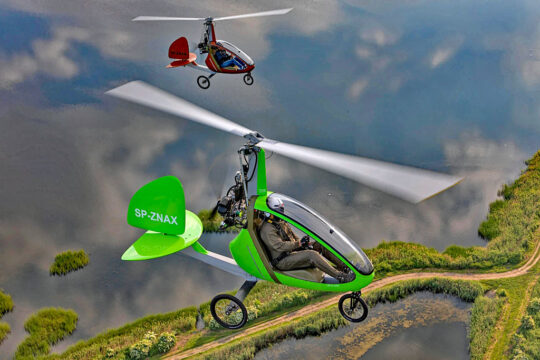 I reflected back that this cleanly executed Nano had the same effect on me when I first saw it at AirVenture Oshkosh 2021. A glance at this eye-catching design, beautiful in its simplicity and compact in its features (see on trailer or in shipping crate) suggested to me that JK-2 Nano could find a market.
I reflected back that this cleanly executed Nano had the same effect on me when I first saw it at AirVenture Oshkosh 2021. A glance at this eye-catching design, beautiful in its simplicity and compact in its features (see on trailer or in shipping crate) suggested to me that JK-2 Nano could find a market.
For more than a decade, interest in gyroplanes has been strong. After European designers took earlier American simple gyros and transformed them into sleek aircraft, a wider range of pilots looked at them more positively. However, those more elegant and feature-laden designs steadily rose in price. While still a bargain compared to many fixed wing aircraft — especially considering that prices on everything have risen dramatically in the last three years — the fanciest gyroplanes are now much more costly and complex.
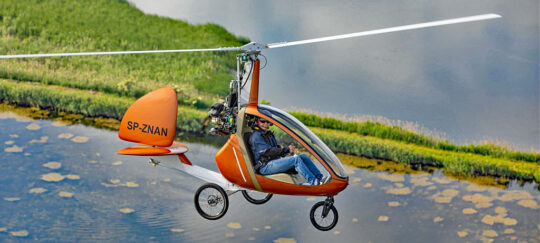
As U.S. importer, Jeffrey heard all this and encouraged business owner Jacek Lichota and designer Jaroslaw Kowlski to bring extra power to the design. Buyers now have two choices and both remain quite economic. In fact, their prices have only crept up gently while many things you purchase have leaped in price. We’ll talk cost below.
For 2023, Nano has engines that many pilots want.
JK-2 Nano
by Fusioncopter
“Nano is a true Part 103 Ultralight gyroplane,” said manufacturer Fusioncopter. As it easily qualifies for Part 103 (specifications below) no license is required, “but training is strongly encouraged,” they added. Made in Poland, Nano is imported to the USA by F.U.N. (Fly Ultralight Nano), operating from the municipal airport in Ann Arbor, Michigan (KARB).
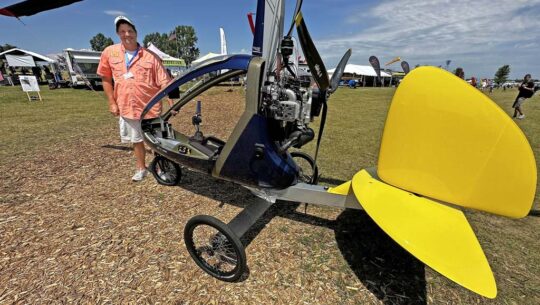
A Part 103 ultralight vehicle, Nano is a simple gyroplane but one with a cabin and aluminum structure. Nano’s standard engine is the proven and durable Polini Thor 303, a dual-ignition engine producing 38 horsepower or the Hirth F23 V28CL offering 50 horsepower.
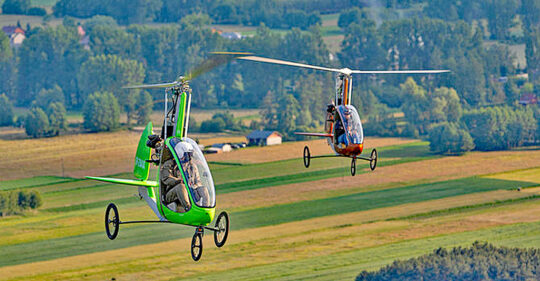
An additional feature is the ease of hangaring the aircraft. After disassembly of the rotor, chassis and tail it takes no more space than a motorcycle (nearby photo on trailer).
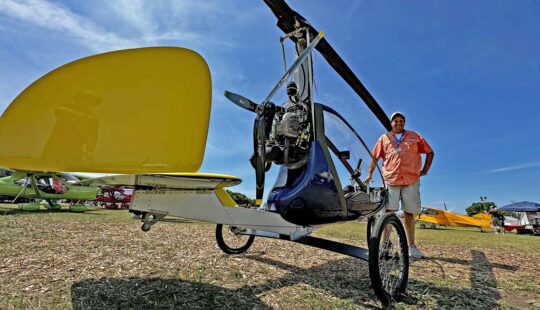
Jeffrey reports a climb performance of 1,300 fpm with the more potent Hirth, compared to 400 fpm with the Polini. Lighter pilots at lower elevations may find the Polini sufficiently energetic. No matter what engine you select, Part 103 regulations limit all ultralight vehicles to 55 knots airspeed (63 mph).
Changes made or planned since Oshkosh 2023 — Jeffrey reported that Nano will get two more inches of headroom inside a new canopy shape. That small difference will be appreciated by taller pilots. A fuel sight gauge has been incorporated into the lower fairing so you can easily check quantity before takeoff. It’s a prior feature but the simple digital instrument can show direction back to a home field or other waypoints in addition to many engine-reporting functions.
How Much Is Nano?
“A JK-2 Nano kit can be assembled in a lazy weekend, with only 19 bolts to install,” said Jeffrey. “The kit price, with the new Hirth engine is €27,295” ($28,850 on the date this article was posted), he added. Some pilots prefer optional fuel injection, which adds €2,000 Euros ($2,115 at this time).
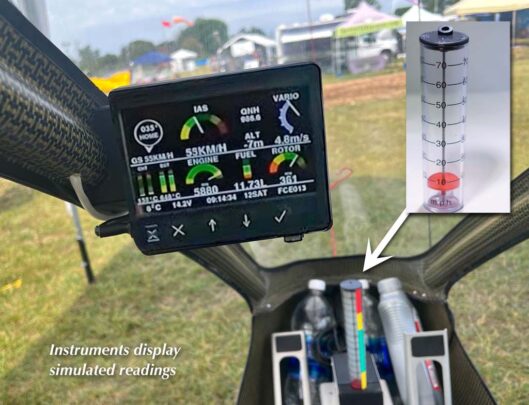
For a full, delivered price, it’s best to assume $33-35,000 for a delivered Hirth-powered Nano JK-2. With the average price of a car in America now more than $48,000, I think Nano is a wonderful bargain… and doesn’t it just look fun?
TECHNICAL SPECIFICATIONS:
Fusioncopter JK-2 Nano gyroplane
all information provided by U.S. importer, FUN
- Rotor diameter — 23 feet
- Length without rotor — 11.5 feet
- Wide without rotor — 5.5 feet
- Height — 8 feet
- Empty Weight (Polini Thor 303) with coolant and hydraulic fluid — 220 pounds
- Empty weight (Hirth F23) — 253 pounds
- Maximum Take-off Weight (Polini Thor 303) — 440 pounds
- Maximum Take-off Weight (Hirth F23) — 518 pounds
- Fuel Capacity (per 103 regulations) — 5 gallons
- Performance (Hirth F23)
- Never Exceed Speed — 68 miles per hour
- Maximum Speed Vmax — 63 miles per hour (level flight, limited by Part 103)
- Minimum Speed Vmin — 22 miles per hour
- Cruising Speed — 53 miles per hour
- Maximum Climb Rate — 1,375 feet per minute (at sea level)
- Take-off Run — 150-300 feet (depending on surface, wind, pilot weight and fuel level)
- Landing Roll — 15-30 feet
- Fuel Consumption —3 to 3.75 gallons per hour
- MTOW — 518 pounds
Performance (with Polini Thor 303) - Never Exceed Speed Vne —68 miles per hour
- Maximum Speed Vmax — 56 miles per hour
- Minimum Speed Vmin — 22 miles per hour
- Cruising Speed — 50 miles per hour
- Maximum Climb Rate — 400 feet per minute
- Take-off Run — 150-300 feet (depending on surface, wind, pilot weight and fuel level)
- Landing Roll — 15-30 feet
- Fuel Consumption — 2.3 to 2.6 gallons per hour
- MTOW — 440 pounds
Construction: - Main supporting structure — metal
- Composite carbon elements
- Fairing of the cabin and the seat made of carbon-Kevlar composite
- 20-inch main wheels
- Cushioned front swingarm
- 16-inch front wheel
- Metal rotor, profile developed by Fusioncopter
- Hydraulic prerotation system
- Engine — Polini Thor 303, 38 horsepower, dual ignition, electric start
- Engine — Hirth F23 V28CL, 50 horsepower, dual ignition, electric start
Options (at additional cost — add ≈6% for US dollars): - USB charger socket – €51.50
- Aluminum wheel (type 2) – €100; available on Polini model only
- Front stabilizing brace for travel – €257.50
- Color (metallic) – €515
- Painted rims – €206
ARTICLE LINKS:
- Fly Ultralight Nano (FUN), contact info and all content on this website
- First appearance of Nano at Oshkosh 2021
- Article from 2021 on an electric project for Nano gyro
- Original article covering two light rotary aircraft including Nano gyro, from 2020; includes a video (scroll down)
- FUN’s video page, with several short videos


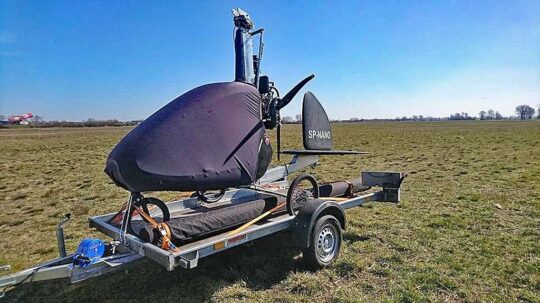
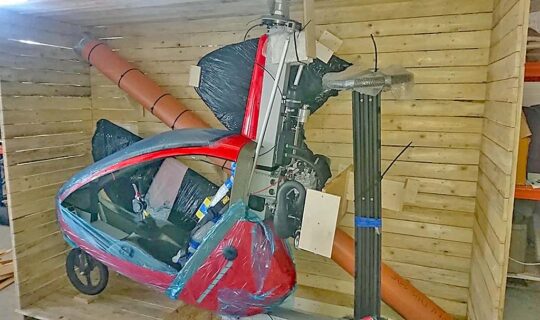
They are pretty neat! I’m just admiring. I don’t have that kind of money! That would be a great job, to test them! Y’all have a blessed day. D Farly
I use to have one; never learned to fly it.
Where are you getting a Hirth… banko??
Support?
Looking for lessons.
Where can I find a dealer in Mesa, Arizona?
What is the size of the fuel tank? Is two fuel tanks optional?
Without a pilots license, fuel capacity is limited to 5 gal.
I would like to know more about what kits are available without a license. Financing, shipping cost, etc. Gyroplane 103 and others. Thank you
What does the addition of fuel injection do for performance on the Hirth F23 50-hp engine?
It’s easier to start cold engine. A very little savings on fuel consumption. Fuel pump need to be powered electrically. Carburetor versions runs as long as it has fuel.
The price is quite high for this Part 103 gyroplane compared to other single seat Ultralights.
I am a licenced rotorcraft pilot.
Like to know the full cost of the Nano with the F23 engine to my address: 51 West Laynewood Ct., Rineyville KY 40162
By all means, use links in the article to contact FUN.
Under what circumstances can the maximum speed be closer to 75 miles an hour? Thank you.
Does it carry any navigational instruments?
Part 103 is limited to 63 miles an hour. To go 75 mph the aircraft will have to be Experimental Amateur Built.
Do you need to be liscensed to fly this?
No, but FUN will not sell you one without determining if you can fly it.
Reminds me of a Joseph Heller novel.
Nice
It looks and sounds so Attractive ❤️
Almost feel like in the movies but I guess the times have come … I’m not sure tough how safe it is since you have to learn it all on your own as there is only 1 seat
Could this be a ticking bomb?
I’m interested and would like a little more information
I like this Nano very much. It would be nice to be able to jump from lake to lake. Is it possible to put some floats on so it could do that?
I’m pleased to see the continued interest in gyros. As a kid, I used to see pictures of those impossibly simple looking Benson gyros. Historically young, Aviation in all forms will live on!
Are you looking for a distributor in the north Georgia area?
Contact me at info@fusioncopter.eu